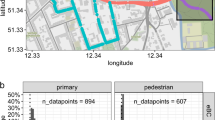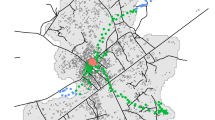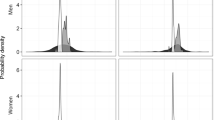Abstract
Individuals spend the majority of their time indoors; therefore, estimating infiltration of outdoor-generated fine particulate matter (PM2.5) can help reduce exposure misclassification in epidemiological studies. As indoor measurements in individual homes are not feasible in large epidemiological studies, we evaluated the potential of using readily available data to predict infiltration of ambient PM2.5 into residences. Indoor and outdoor light scattering measurements were collected for 84 homes in Seattle, Washington, USA, and Victoria, British Columbia, Canada, to estimate residential infiltration efficiencies. Meteorological variables and spatial property assessment data (SPAD), containing detailed housing characteristics for individual residences, were compiled for both study areas using a geographic information system. Multiple linear regression was used to construct models of infiltration based on these data. Heating (October to February) and non-heating (March to September) season accounted for 36% of the yearly variation in detached residential infiltration. Two SPAD housing characteristic variables, low building value, and heating with forced air, predicted 37% of the variation found between detached residential infiltration during the heating season. The final model, incorporating temperature and the two SPAD housing characteristic variables, with a seasonal interaction term, explained 54% of detached residential infiltration. Residences with low building values had higher infiltration efficiencies than other residences, which could lead to greater exposure gradients between low and high socioeconomic status individuals than previously identified using only ambient PM2.5 concentrations. This modeling approach holds promise for incorporating infiltration efficiencies into large epidemiology studies, thereby reducing exposure misclassification.
This is a preview of subscription content, access via your institution
Access options
Subscribe to this journal
Receive 6 print issues and online access
$259.00 per year
only $43.17 per issue
Buy this article
- Purchase on Springer Link
- Instant access to full article PDF
Prices may be subject to local taxes which are calculated during checkout




Similar content being viewed by others
Abbreviations
- a :
-
air exchange rate (h−1)
- a 1 :
-
coefficient describing the penetration, deposition, and exfiltration of ambient PM2.5
- a 2 :
-
coefficient describing the deposition and exfiltration of indoor PM2.5
- B sp :
-
particle light scattering coefficient
- F inf :
-
infiltration efficiency
- FHA:
-
forced hot air heat
- GBPS:
-
Georgia Basin Puget Sound airshed
- GIS:
-
geographic information system
- HVAC:
-
heating, ventilation, and air conditioning systems
- k :
-
particle deposition rate (h−1)
- Neph:
-
Radiance Research nephelometer
- P :
-
particle penetration efficiency (unitless)
- PM:
-
particulate matter
- PM2.5:
-
particulate matter with an aerodynamic diameter less than 2.5 μm
- RM:
-
recursive model
- SPAD:
-
spatial property assessment data
References
Allen R., Larson T., Sheppard L., Wallace L., and Liu L.-J.S. Use of real-time light scattering data to estimated the contribution of infiltrated and indoor-generated particles to indoor air. Environ Sci Technol 2003: 37: 3485–3492.
Allen R., Mar T., Koenig J., Liu S., Gould T., Simpson C., and Larson T. Changes in lung function and airway inflammation among asthmatic children residing in a woodsmoke-impacted Urban Area. Inhal Toxicol 2008: 20: 423–433.
Allen R., Wallace L., Larson T., Sheppard L., and Liu S. Evaluation of the recursive model approach for estimating particulate matter infiltration efficiencies using continuous light scattering data. J Expo Sci Environ Epidemiol 2007: 17: 468–477.
Barn P., Larson T., Noullett M., Kennedy S., Copes R., and Brauer M. Infiltration of forest fire and residential wood smoke: an evaluation of air cleaner effectiveness. J Expo Sci Environ Epidemiol 2007 Advance online publication; doi: 10.1038/sj.jes.7500640.
BAQS. “Border Air Quality Study”. http://www.cher.ubc.ca/UBCBAQS/welcome.htm(20 July 2007).
BC Stats. Dwelling Characteristics and Household Equipment. http://www.bcstats.gov.bc.ca, 2002 February 2007.
Chan W., Nazaroff W., Price P., Sohn M., and Gadgil A. Analyzing a database of residential air leakage in the United States. Atmos Environ 2005: 39 (19): 3445–3455.
Chao C.Y.H., and Tung T.C. An empirical model for outdoor contaminant transmission into residential buildings and experiment verification. Atmos Environ 2001: 35 (9): 1585–1596.
Dockery D.W., Pope A., Xu X., Spengler J.D., Ware J.H., Fay M.E., Ferris B.G., and Speizer F.E. An association between air pollution and mortality in six U.S. cities. NEJM 1993: 329 (24): 1753–1759.
Dominici F., McDermott A., Zeger S.L., and Samet J.M. National maps of the effects of particulate matter on mortality: exploring geographical variation. Environ Health Perspect 2003: 111: 39–43.
Ebelt S., Petkau A., Vedal S., Fisher T., and Brauer M. Exposure of chronic obstructive pulmonary disease patients to particulate matter: relationships between personal and ambient air concentrations. J Air Waste Manag Assoc 2000: 50 (7): 1081–1094.
Ebelt S., Wilson W., and Brauer M. Exposure to ambient and nonambient components of particulate matter: a comparison of health effects. Epidemiology 2005: 16 (3): 396–405.
Gunier R., Hertz A., Behren J., and Reynolds P. Traffic density in California: socioeconomic and ethnic differences among potentially exposed children. J Expo Anal Environ Epidemiol 2003: 13 (3): 240–246.
Hanninen O.O., Palonen J., Tuomisto J.T., Yli-Tuomi T., Seppanen O., and Jantunen M.J. Reduction potential of urban PM2.5 mortality risk using modern ventilation systems in buildings. Indoor Air 2005: 15 (4): 246–256.
Janssen N.A.H., Schwartz J., Zanobetti A., and Suh H.H. Air conditioning and source-specific particles as modifiers of the effect of PM10 on hospital admissions for heart and lung disease. Environ Health Perspect 2002: 110 (1): 43–49.
Jerrett M., Burnett R., Brook J., Kanaroglou P., Giovis C., Finkelstein N., and Hutchison B. Do socioeconomic characteristics modify the short term association between air pollution and mortality? Evidence from a zonal time series in Hamilton, Canada. J Epidemiol Commun Health 2004: 58: 31–40.
Klepeis N.E., Nelson W.C., Ott W.R., Robinson J.P., Tsang A.M., Switzer P., Behar J.V., Hern S.C., and Engelmann W.H. The National Human Activity Pattern Survey (NHAPS): a resource for assessing exposure to environmental pollutants. J Expo Anal Environ Epidemiol 2001: 11 (3): 231–252.
Koenig J.Q., Mar T.F., Allen R.W., Jansen K., Lumley T., and Sullivan J.H. Pulmonary effects of indoor- and outdoor-generated particles in children with asthma. Environ Health Perspect 2005: 113: 499–503.
Larson T., Su J., Baribeau A.M., Buzzelli M., Setton E., and Brauer M. Spatial model of urban winter woodsmoke concentrations. Environ Sci Technol 2007: 41: 2429–2436.
Liu L.J.S., Box M., Kalman D., Kaufman J., Koenig J., Larson T., Sheppard L., and Wallace L. Exposure assessment of particulate matter for susceptible populations in Seattle. Environ Health Perspect 2003: 111: 909–918.
Liu L.J.S., Slaughter J.C., and Larson T.V. Comparison of light scattering devices and impactors for particulate measurements in indoor, outdoor, and personal environments. Environ Sci Technol 2002: 26: 2977–2986.
McKone E., Thatcher T., Fisk W., Sextro R., Sohn M., Delp W., and Riley W. Factors affecting the concentration of outdoor particles indoors: existing data and data needs, 2002 Lawrence Berkeley National Laboratory. Paper LBNL-49570.
Meng Q.Y., Turpin B.J., Polidori A., Lee J.H., Weisel C., Morandi M., Colome S., Stock T., Winer A., and Zhang J.F. PM2.5 of ambient origin: estimates and exposure errors relevant to PM epidemiology. Environ Sci Technol 2005: 39 (14): 5105–5112.
Mosley R.B., Greenwell D.J., Sparks L.E., Guo Z., Tucker W.G., Fortmann R., and Whitfield C. Penetration of ambient fine particles into the indoor environment. Aerosol Sci Technol 2001: 34: 127–136.
O'Neill M.S., Jerrett M., Kawachi I., Levy J.I., Cohen A.J., and Gouveia N., et al. Health, wealth, and air pollution: advancing theory and methods. Environ Health Perspect 2003: 111: 1861–1870.
Ozkaynak H., Zufall M., Burke J., Xue J., and Zidek J. A probabilistic population exposure model for PM10 and PM2.5. Epidemiology 1999: 10 (4): S79–S79.
Peng R.D., Dominici F., Pastor-Barriuso R., Zeger S.L., and Samet J.M. Seasonal analyses of air pollution and mortality in 100 US cities. Am J Epidemiol 2005: 161: 585–594.
PSCAA. “Puget Sound Clean Air Agency”. www.pscleanair.org(23 July 2007).
Pope C.A. Epidemiology of fine particulate air pollution and human health: biological mechanisms and who's at risk? Environ Health Perspect Supplement 2000: 108 (S4): 713–724.
Rotko T., Koistinen K., Hanninen O., and Jantunen M. Sociodemographic descriptors of personal exposure to fine particles (PM2.5) in EXPOLIS Helsinki. J Expo Anal Environ Epidemiol 2000: 10: 385–393.
Schwartz J. Air pollution and daily mortality in Birmingham, Alabama. Am J Epidemiol 1993: 137 (10): 1136–1147.
Setton E., Hystad P., and Keller P. Opportunities for using spatial property assessment data in air pollution exposure assessments. Int J Health Geogr 2005: 4 (26): 1–8.
Sherman M.H., and Chan R. Building airtightness: research and practice. Energy Efficiency and Renewable Energy, Building Technology Program of the U.S. Department of Energy 2004.
Sherman M., and Dickerhoff P. Air tightness of US dwellings. Report conducted by Lawrence Berkley Laboratory's. DE-AC03-76SF00098 1998.
Sherman M.H., and Matson N.E. Air tightness of new houses in the US. Proceedings, 22nd Air Infiltration and Ventilation Proceedings 2001.
Sioutas C., Kim S., Chang M., Terrell L., and Gong H.J. Field evaluation of a modified DataRAM MIE scattering monitor for real-time PM2.5 mass concentration measurements. Atmos Environ 2000: 34: 4829–4838.
Strand M., Hopke P., Zhaoc W., Vedald S., Gelfande E., and Robinovitche N. A study of health effect estimates using competing methods to model personal exposures to ambient PM2.5. J Expo Sci Environ Epidemiol 2007 Advance online publication; 16 May.
Strand M., Vedal S., Roges C., Dutton S., Welfand E., and Rabinovitch N. Estimating effects of ambient PM2.5 exposure on health using PM2.5 component measurements and regression calibration. J Expo Sci Environ Epidemiol 2006: 16: 30–38.
Thornburg J., Ensor D.S., Rodes C.E., Lawless P.A., Sparks L.E., and Mosley R.B. Penetration of particles into buildings and associated physical factors. Part I: model development and computer simulations. Aerosol Sci Technol 2001: 34 (3): 284–296.
Victoria Weather. “The Victoria School Weather Project”. www.victoriaweather.ca/(23 July, 2007).
Waggoner A.P., and Weiss R.E. Comparison of fine particle mass concentration and light scattering extinction in ambient aerosol. Atmos Environ 1980: 14: 623–626.
Wallace L. Indoor particles: a review. J Air Waste Manag Assoc 1996: 46 (2): 98–126.
Wallace L., and Williams R. Use of personal-indoor-outdoor sulfur concentrations to estimate the infiltration factor and outdoor exposure factor for individual homes and persons. Environ Sci Technol 2005: 39 (6): 1707–1714.
Wallace L.A., Mitchell H., O'Connor G.T., Neas L., Lippmann M., Kattan M., Koenig J., Stout J.W., Vaughn B.J., Wallace D., Walter M., Adams K., and Liu L.J.S. Particle concentrations in inner-city homes of children with asthma: the effect of smoking, cooking, and outdoor pollution. Environ Health Perspect 2003: 111 (9): 1265–1272.
Watson J.M., Scarinci I.C., Klesges R.C., Murray D.M., VanderWeg M., DeBon M., Eck-Clemens L.H., Slawson D.L., and McClanahan B. Relationships among smoking status, ethnicity, socioeconomic indicators, and lifestyle variables in a biracial sample of women. Prev Med 2003: 37: 138–147.
Wilson W., and Brauer M. Estimation of ambient and non-ambient components of particulate matter exposure from a personal monitoring panel study. Expo Sci Environ Epidemiol 2006: 16: 264–274.
Wilson W., Mage D.T., and Grant L.D. Estimating separately personal exposure to ambient and nonambient particulate matter for epidemiology and risk assessment why and how. J Air Waste Manag Assoc 2000: 50 (7): 1167–1183.
Acknowledgements
We thank the participants of this study. We are also grateful to researchers at the University of Washington and the EPA Northwest Center for Particulate Air Pollution and Health for sharing data and infiltration estimates from the Seattle panel study. This research was carried out as part of the Border Air Quality Study (BAQS) funded by Health Canada through an agreement with the British Columbia Centre for Disease Control. A number of researchers within BAQS provided invaluable guidance and advice throughout the research.
Author information
Authors and Affiliations
Corresponding author
Additional information
For submission to the Journal of Exposure Science & Environmental Epidemiology 05 November 2007.
The views expressed in this paper do not necessarily reflect the views or policies of Health Canada.
Rights and permissions
About this article
Cite this article
Hystad, P., Setton, E., Allen, R. et al. Modeling residential fine particulate matter infiltration for exposure assessment. J Expo Sci Environ Epidemiol 19, 570–579 (2009). https://doi.org/10.1038/jes.2008.45
Received:
Accepted:
Published:
Issue Date:
DOI: https://doi.org/10.1038/jes.2008.45
Keywords
This article is cited by
-
Development of a Canadian socioeconomic status index for the study of health outcomes related to environmental pollution
BMC Public Health (2015)
-
Risk-based indicators of Canadians’ exposures to environmental carcinogens
Environmental Health (2013)
-
A new exposure metric for traffic-related air pollution? An analysis of determinants of hopanes in settled indoor house dust
Environmental Health (2013)
-
A local initiative for mobile monitoring to measure residential wood smoke concentration and distribution
Air Quality, Atmosphere & Health (2013)
-
Air pollutants and sources associated with health effects
Air Quality, Atmosphere & Health (2012)



